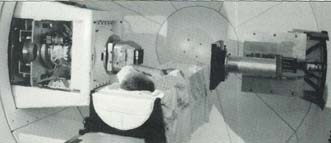Proton Therapy Lives Up to its Promise

The world's first and so far only hospital-based Proton Treatment Center opened in October, 1990, at Loma Linda University Medical Center
Well into its third year of treating cancer patients, Loma Linda University Medical Center's Proton Treatment Center is fulfilling a vision of the future that medical scientists and physicists dreamed about for more than 40 years.
Skeptics said it wouldn't work. Many said it was too complicated and the machine (the first proton-beam accelerator built for hospital use), if ever built, would never run long enough to treat patients on a routine basis. Some predicted that the accelerator would be a white elephant. Others complained that its untested medical benefits and high price tag would make it the ultimate example of medical technology run amok. Some said that proton therapy would prove useless in the treatment of most cancers.
The skeptics are being proven wrong. When physicists unveiled the proton accelerator for the first time in 1989 at Fermi National Accelerator Laboratory, physicians at Loma Linda, who had been intrigued with proton cancer therapy since the early 1970's, predicted it would become a major tool in the war on cancer. Protons were first suggested as a potential cancer therapy in 1946 by Robert Wilson, who established Fermilab. Wilson's vision proved to be accurate.
The world's first and so far only hospital-based Proton Treatment Center opened in October, 1990. When the Center's first gantry came on line in 1991, it was another milestone in medical history. The gantry is a device that looks like a giant Ferris wheel as it rotates a full 360 degrees and allows physicians to direct the proton beam from virtually any angle and treat rumors anywhere in the body.
The Proton Center will reach another milestone later this summer when the second of three gantry systerns becomes operational. A third gantry will come on line this year, representing the last major hurdle in the development of a full-scale, state-of-the-art system that has the potential to replace most forms of radiation therapy and possibly render some types of surgery unnecessary.
The accelerator itself represents a major engineering accomplishment. In the past 30 months, the machine has been "down" for maintenance less than 4 days. It has been operating nearly 99 percent of the time needed to treat 35-45 patients a day.
Approximately one-half million localized cancers are treated in the U.S. each year with radiation alone or in conjunction with other forms of treatment such as surgery and chemotherapy. Now a successful new weapon, proton therapy, is finding its way into the anticancer arsenal. And, despite the fact that protons are in the early stages of clinical development, they are getting widespread attention worldwide as well as in the U.S. The success at Loma Linda, especially with treatment of tumors in the eye, brain, head and neck, lung, pancreas, bladder, and prostate, has stimulated interest for proton facilities within the scientific and medical communities of France, Switzerland, Japan, Russia, Canada, Germany, Italy, and Czechoslovakia.
X-rays (conventional radiation), are harder to control than protons. X-rays tend to scatter and damage healthy tissues to the sides of and behind a tumor. The results are unnecessary side effects. To avoid complications, physicians often lower radiation dosages to spare healthy tissue. But that can allow malignant cells to survive. Protons, on the other hand, go precisely where the physicians want them to go and no farther. So, while a tumor is being bombarded by protons, surrounding normal tissue is left intact; the patient is spared debilitating side effects.
At Loma Linda, 500 patients have been treated at the Proton Treatment Center since it opened. With two more gantries available, that number will double by the end of this year. The patients, who come from just about every state in the union and from foreign countries, are living proof that proton therapy is having an effect on the control of cancer and the relief of pain and suffering. These people represent a new hope and a new era in the possibility for an improved quality of life for cancer patients.


